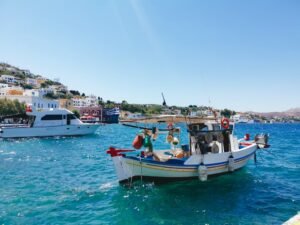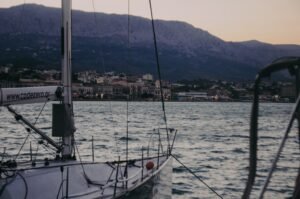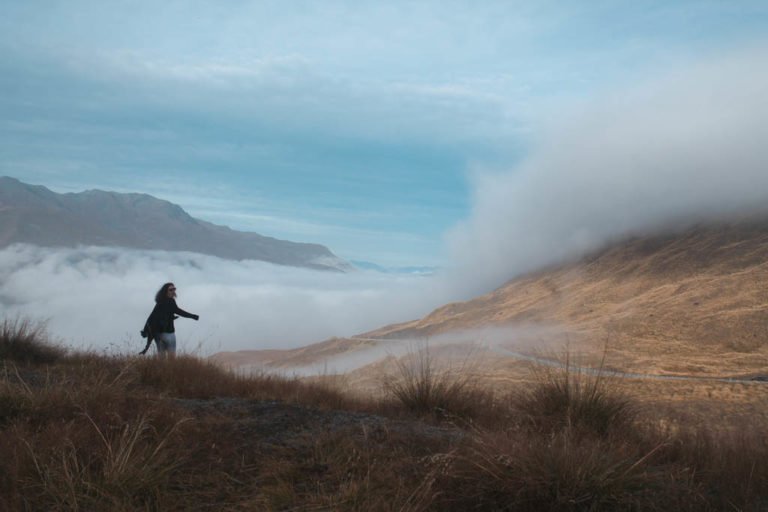This article may contain affiliate links. When you purchase something we recommend, we make a small commission. You don’t pay anything extra. 💘 For more details, check out our Terms of Use page.
Some Greek islands like Mykonos and Santorini get a lot of press. Others like Leros, fall through the cracks and become hidden finds.
This is the story of the latter. An island that might not make the front page of glossy travel mags but will surprise you with its variety, cultural layers, and unexpected charm. It’s a place that feels both lived-in and quietly intriguing.
It is ideal for families, foodies, history lovers, and anyone with a soft spot for mystery and WWII energy, especially if you like conspiracy theories!
Let’s get started!

Table of Contents
ToggleWhere is Leros
Leros is part of what we Greeks refer to as the Dodecanese complex of islands. This is the cluster of islands closest to Turkey covering the southeastern part of the Aegean Sea.
Leros is posisitoned between Patmos (famous for religious tourism) and Kalymnos (famous for sponge diving).
The island is small in size, just over 75 square kilometers, so roughly the size of Manhattan.
How to Get to Leros
By Plane
By Ferry

Weather in Leros
Like most Greek islands, late spring and late summer into autumn are ideal if you are not a fan of the heat. The weather is warm, the sea is still swimmable, and the island feels relaxed without being empty.
Mid-summer is peak season, especially July. In August, expect the busiest period as many Greeks arrive for their own holidays.
Winter is doable but offers a very different experience. You might even get snow, though it is rare. Ferries are more likely to be delayed or cancelled due to storms, and most shops, beach bars, and tourist services will be closed.


Getting Around the Island
Leros is small enough that you can see a lot in just a few days, but you will need some kind of transport to get around comfortably. Public transport is minimal, especially outside the summer months, so renting a car or scooter is the easiest way to explore the island at your own pace.
Taxis do exist but can be hard to find on short notice, especially if you are not staying near one of the main villages. There are also a few local buses that run between Lakki, Agia Marina, and Alinda, mostly in high season, but the schedule is limited and not always up to date online.
If you plan to visit more remote beaches, the War Museum, or the hills above Partheni, having your own wheels is highly recommended. Roads are generally in good condition, traffic is minimal, and the distances are short. A small car will be more than enough.
Parking is free in most places and easy to find, except maybe around Agia Marina in the evenings.
All in all, I would say a car or some vehicle is mandatory if you are planning on seeing the island in full.
Even in the middle of summer, you can find medium sized cars for less than $40 a day, if you book in advance.
I use and compare prices for car rentals, with Discovercars.com. It is a giant rental and comparison site on the market and it has a lot of perks that make sense if you travel often.
Once you head to Discover Cars, you’ll find an easy search engine to filter by location, dates and pick up location.
Tip: Always check a few different pick up locations when booking a rental car.
Things to Do in Leros
Visit the Beaches
Leros offers a ton of options, with more than 20 beaches for visitors to choose from.
I found the beaches on Leros to be on the rough side, which is definitely something you either love or hate. They are not overly polished or manicured, and a lot of them retain the pebbly, stony feel they have always had. You will still find organized spots if you prefer, though.


Paralia Kokkina
Located near the War Museum close to Lakki, this beach has small pebbles and a wide, open stretch of coast. There are small bits of natural shade here and there, and it rarely gets crowded.
Vromolithos
From Lakki, you will reach Vromolithos on the east side of the island as you head north toward Agia Marina. A wide and semi-organized beach, it is one of the most beautiful and accessible on the island.
Gourna
Gourna Beach is one of the most popular beaches on the west side of the island. It can easily be combined with an evening visit to the nearby Church of Agios Isidoros, although you will need a car. The waters are shallow but cold, making it well suited for children.
Blefoutis
Up in the north part of the island, Blefoutis can be a bit hit or miss depending on the weather and what you are looking for. It has stunning turquoise waters and small pebbles. There is a taverna nearby and plenty of tamarisk trees for shade, although it does tend to get quite busy.


Dio Liskaria
This was one of my favorite beaches on the island, both in terms of how it is set up and how it manages to stay tucked away in a cove. There is also so much to discover underwater. Plenty of rocks in some areas, which can either be the greatest joy to jump from or annoying if you do not want to walk on them. A few beach bars nearby serve food and drinks. It also tends to be a bit warmer than other beaches on the island, which are known for their colder waters.

Explore the Villages
A lot of Greek islands are pretty to walk around. They have whitewashed alleys, blooming bougainvillea, and pastel houses on hillsides. But not all of them offer the kind of sharp contrasts that Leros does between postcard views and the weight of 20th-century history.
Lakki
Lakki is not just unusual for a Greek island it is completely unexpected. It was built under Mussolini’s direction during the Italian occupation, when Greece was under Axis control and the Dodecanese islands were seen as strategic naval territory. It wasn’t occupied by the locals as an area before that.
Mussolini (Hitler’s BFF) had big plans for Leros. He wanted to turn this part of the island into a model naval base and showcase of Italian power. So he built hotels, cinemas, schools, and naval buildings. The now-iconic clock tower, the old cinema, and many of the flat-roofed, curved buildings you see today were all part of that vision.
The architecture is strongly influenced by Art Deco and Italian Rationalism. Some say the architects drew inspiration from Giorgio de Chirico—the Italian artist known for eerie, empty cityscapes that blend classical arches with surreal silence. They also borrowed geometric features from ancient temples to give the town a sense of order and permanence.
The result is Lakki. Wide streets, odd symmetry, faded elegance. It feels nothing like the rest of Greece, and yet it tells a story that is deeply tied to the island’s past.
Walking around here is like stumbling into a forgotten experiment that resembles part military base, part fascist dream and if you like architecture, this will fascinate you.
I would definitely recommend staying in Lakki if you want to explore more of the southern part of the island, even though the distances are quite small so it won’t make a huge difference.



Agia Marina
Agia Marina is where Leros starts to feel more familiar in the best way.
By that I mean, the typical Greek island setting we seek to find. It has a small, charming port lined with fishing boats and ferries, and it is the kind of place where you can easily spend an afternoon doing very little. Walk around the alleys, grab a coffee, browse a few shops, and suddenly it’s sunset.
The vibe here is relaxed. There is none of that loud, in-your-face energy you get on more touristy islands. Just a steady rhythm of locals, visitors, and cats weaving through the narrow backstreets.
Food-wise, Agia Marina is one of the best places to eat on the island. Whether you want seafood by the water or a late-night gyros, this is where most of the action is. In the evening, the port and nearby streets fill up with people out for dinner or drinks, and the energy picks up just enough to feel lively without becoming chaotic.
It is also one of the easiest areas to stay in. You are close to the beach, close to the castle, and well-connected to the rest of the island. If you want a little bit of everything—walkability, views, local flavor, and some nightlife without the chaos—this is where you want to be.






Why to read the history
The Italians occupied the island and the rest of the Dodecanese long before WWII, going back to 1912. After Italy surrendered in 1943, Germany moved in, seeing an opportunity as Italy and Germany split. That triggered the fierce Battle of Leros—with Italian troops, British reinforcements from Samos, and eventually German forces locked in combat until mid-November 1943.
What most people don’t know is that after the war ended, there were even discussions—secret ones—about sending the Dodecanese islands to Turkey instead of Greece. Both Greece and Turkey had interests here. But ultimately, Greece secured them through the 1947 Treaty of Paris, and Turkey formally renounced its claim
Explore Historical and Cultural Sites
The Bunker with the Paintings
One thing that is not well known about Leros and honestly, a shame considering the weight of its history is just how many Nazi bunkers and military structures still exist on the island. What’s even more frustrating is how little has been done to preserve or even acknowledge these spaces as historical sites. They are quietly disappearing, fading into goat fields and hillside brush.
The bunker with the paintings is the best example of that. And for me, it was the most vivid memory of the entire trip.
We almost didn’t find it. There are no signs, no path, nothing that tells you where to go. We followed a rough track through some hills where sheep wandered freely, hoping we were in the right place. Eventually, we came across a structure built into the hillside and noticed the bunker (with such a great viewpoint).
Inside, the walls are covered with paintings. Not just random sketches, but large, detailed replicas of Pieter Bruegel works like The Peasant Wedding and The Peasant Dance. Some rooms are filled with satirical animal drawings or a girl in an elegant dress. One room looks like it was the kitchen, another the barracks each space still carrying traces of what it once was.
The soldier who painted all this was Otto Meister. No one knows much about him, but his work still covers the walls. Some of it is surprisingly beautiful. Some of it is unsettling. But most of it will eventually be destroyed.
There’s no protection around it. The paint is fading. Goats sleep in the old barracks. Locals told us the vandalism is getting worse, and even without that, time and weather are eating away at everything. And it brings up a difficult question what do we preserve, and why? Is it worth restoring a Nazi bunker to show what went on there? Or do we let it collapse into the hillside and forget?
I felt incredibly lucky to see it like this but I also left wondering how much longer it will last. And whether anyone else will get the chance to stand in that same spot before it’s gone completely.









The Radio Station Near Lakki
This is another one of those places that makes you stop and think, how is this still here? It is just a short walk from the village of Lakki, right near people’s homes, and yet what stands there is the old radio station used during the occupation to spread Nazi propaganda through the infamous Volksempfänger system.
The building is falling apart but still holds a strange presence. Inside, one full wall is covered by a massive swastika, painted in fading green tones. Locals told us that not long ago, you could still find old instruments, paper logs, and pieces of furniture left inside. Some of it was military, some civilian almost like a time capsule.
Now, most of that is gone. Vandalism and time have stripped the place bare. But the structure itself is still standing.






The Leros War Cemetery
Another spot worth visiting is the Leros War Cemetery, located near Agia Marina and just a short walk from the beach.
A total of 183 soldiers are buried here, most of them from the Commonwealth forces who died during the Battle of Leros in 1943. Among them are two airmen from the Royal Canadian Air Force and two soldiers from the South African forces.

Church of Panagia Kavouradena
Down in the southern part of the island, near the area where you might also go searching for the bunker with the Bruegel paintings, you’ll find the small church of Panagia Kavouradena. It is easy to miss if you’re not looking for it but well worth the stop.
Unlike most Greek churches that lean into white and blue, this one has a distinct pop of red on its roof. It is built directly into the rockface, part chapel, part cave, and stands right above the sea.
According to tradition, a fisherman was bitten by a crab while collecting shells. At that moment, he saw an icon of the Virgin Mary on the rocks. He prayed, and his wound healed. He brought the icon to the village, but that night he dreamt of a woman in black who told him to return it to where he found it. So they built a church on that exact spot.
The icon is now considered miraculous and is celebrated every year on the 8th of September.


Archaeological Museum of Leros
I always make it a point to stop at the archaeological museums of the places I visit.
Housed in a neoclassical building right in Agia Marina, the Archaeological Museum of Leros is small but worth a visit. It features finds from prehistoric to Roman times, including pottery, inscriptions, and tools discovered around the island. It’s a great way to get a sense of Leros’ deep history beyond the beaches and war remnants and it only takes about 20–30 minutes to explore.


War Museum Tunnel
Outside Merikia, near Lakki, you will find the War Museum Tunnel. It is built into the hillside and was originally used by the Italians to store weapons during World War II. Only a few of the tunnels that have been discovered are open to the public today, but even those are enough to give you a sense of what was happening underground.
Lakki has one of the largest natural harbours in the eastern Mediterranean, both in size and depth, which made it a key naval base. These tunnels were used to supply over ten warships at a time.
The museum is not just about weapons. Inside, you will find everything from uniforms and equipment to personal items—letters, toiletries, small tools. That mix of daily life and war gives it more emotional impact than you might expect.



Windmills of Panteli
These are a photographer’s dream and one of the highlights for many visitors to the island. You’ll find them near Panteli, on the way to the castle.
While they were traditionally used to grind grain, their role today is mostly decorative. A few have been preserved and converted into charming guesthouses as well.




Climb to the Castle
Reaching the Castle of Panagia is one of the most rewarding things you can do in Leros, and there are a couple of ways to get there. You can drive most of the way up via the road that passes the Church of Prophet Elias, which is especially nice to visit in the evening when the view and light are just right. Or you can take the stone path from Agia Marina or Panteli, climbing up through the village of Platanos on foot. The walk is beautiful but steep, with lots of stairs, so if you’re going in the summer, bring water and take it slow. Once at the top, you’ll find not just the castle walls and sweeping views of the island, but also small churches and even a couple of museums tucked inside the grounds. Whether you go during the day or late at night, the experience is worth it.












Church of Agios Isidoros
This is one of the most photogenic spots on the island, and for good reason. The Church of Agios Isidoros sits on a small rocky islet just off the coast, connected to the land by a narrow stone walkway. It’s especially beautiful at sunset, when the sky lights up behind the chapel and the whole scene feels like something out of a painting.
If you go around that time, just be careful because the waves often crash over the walkway, and it can get slippery. Bring good shoes and take your time. Whether you are there for the photo or the quiet, it is one of those places that really stays with you.




Where to Eat in Leros
Leros might not be famous for its food scene, but it really should be. You’ll find everything from fresh fish caught that morning to classic island-style pies, simple meze, and hearty stews. Octopus, stuffed zucchini flowers, and a type of soft local cheese often show up on menus, along with good house wine.
Lime Beach Bar
Lime is the kind of place you go for a quick lunch and end up staying until sunset. If you get a good spot, the views are incredible especially in the late afternoon when the sky starts to turn gold. The cocktails are great, the food is simple but flavorful, and the whole vibe is relaxed without trying too hard.
There’s a wooden platform right by the bar that leads into the sea, perfect if you prefer to dive straight in. And if you’re into snorkeling, just off the little harbour in front of the bar there’s a sunken aircraft wing visible at less than three meters deep.




Mylos By the Sea Restaurant
This is the spot on the island, so if you’re visiting during a weekend or holiday, you’ll need a reservation otherwise, good luck. It gets insanely busy, and for good reason. It’s not cheap, but it’s absolutely worth it for the combination of fresh ingredients and Greek flavors done right.
The restaurant is set near the old windmill by Agia Marina, with some of the tables extending right along the shoreline. On a calm evening, it feels like you’re dining on the sea. The menu changes depending on what’s fresh that day, with a mix of seafood and Mediterranean dishes that still stay rooted in tradition.
Even though this place gets a lot of hype, it completely lives up to it.






Paradosiako
This is another local favourite that immediately caught my attention, both for its charming aesthetic and its location near the marina. It’s the kind of spot you’re drawn to instinctively, and luckily, it delivers. Their sweets and pastries are excellent, and the coffee is equally good. They’re especially known for their lemon meringue tart, which is absolutely worth trying. That said, it’s not just a dessert café. They also serve proper meals if you’re after something more filling.




Where to Stay in Leros
Lakki and Agia Marina are both great bases for your stay in Leros, but each offers a different vibe.
Lakki has a more spacious, retro charm with its Italian-era architecture and quiet harbour. It’s a good choice if you want a calmer pace and easy access to beaches like Merikia or even Gourna by car.
Agia Marina, on the other hand, is livelier, closer to the castle and Platanos, with a more traditional island feel. You’ll find charming alleys, boutique shops, and sunset spots within walking distance.
Accommodation-wise, Leros has something for every budget. You’ll find high-end boutique hotels, cozy mid-range guesthouses, and affordable studios that are clean and well-located.
A few great options to consider:
- Bianco Boutique Hotel (Agia Marina): Modern, stylish, and central. Prices in high season tend to run over 100 euro per night.
- Alinda Hotel: A good mid-range option just steps from the beach. Prices range between $70-$80 during August so book ahead.
- Tony’s Beach Hotel (Vromolithos): Friendly, well-priced, and close to tavernas and swimming spots. If you want something away from the main villages, this is a great option with large rooms and a pool.
- Alea Mare Hotel (Alinda): Budget-friendly and relaxed, with great views from the balcony rooms.


You Might Also Enjoy

Leros Travel Guide: The Mysterious Gem in the Dodecanese
Leros isn’t your typical Greek island. Between its Nazi past, the abandoned mental health institute, and a food scene full of surprises, this guide covers what to do, where to stay, and why Leros leaves a mark.

How to Pack for a Week of Sailing the Greek Islands
Getting ready to cruise the Greek islands? A quick and easy guide on what to expect and what to bring.

Kasos Island: 5 Things That Surprised Me + 1 That Didn’t
Kasos Island is one of the lesser-known Greek islands and belongs to a group of islands called the Dodecanese. Before visiting the island I knew very little of its rich heritage, history and culinary traditions. Here are a few things
ESSENTIAL INFORMATION
Must Know When Visiting Greece
- Emergency: Dial 112 for all emergencies. For police, dial 100. For ambulance 166. For fire dial 199.
- Language: English is widely spoken in most tourist areas. Common phrases to learn are “Kalimera” (Good morning), “Yia” (Hello and Bye – informal), and “Efharisto” (Thank you).
- Water: Tap water is safe in Athens, mainland Greece and a small number of islands. Always ask beforehand.
- Driving: Right-hand side, international driving permit recommended. Book your rental car with Discover Cars for the best rates and comparisons across all major and local companies.
- Accommodation: Booking.com for the most options on hotels, apartments and hostels. Free cancellation in a lot of places and no need to pre-pay. Great for their rewards points system.
- Islands: There are a lot of islands, spread out around the country. Start with a map or ferry service to get an idea of travel times. Ferry Scanner is the best for ferry bookings to the Greek islands.
- Activities: From cultural sights to day trips, food tours and city guides, use Get Your Guide.
- Public Transport: For Athens, use the Athens Metro. If you are not renting a car, use Trains (Hellenic Train) or KTEL (Public Buses) services.
- Domestic Airlines: The main airlines for air travel are Aegean Airlines and Sky Express. I recommend Aegean Airlines and its rewards program.
- Taxi: Always use a taxi app, instead of flagging down a taxi from the road. Use FREE Now (formerly BEAT).
- Culture: A siesta nap is still common in less touristy areas. This also means businesses will close between 2 PM – 5 PM. Except for hospitality businesses, everything is closed on Sundays.



